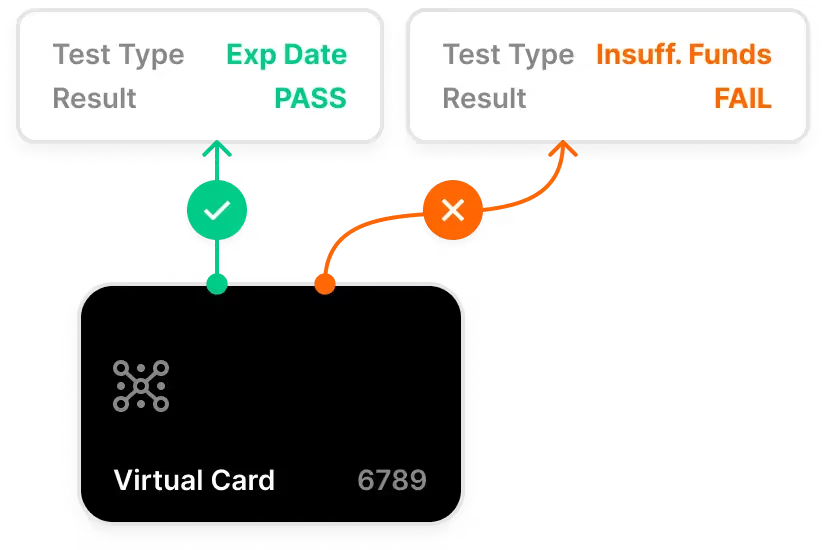Every failed payment is a missed opportunity. For customers, it means frustration with declined payment transactions. For brands, it’s costly — 49% of companies say failed payments are driving up their business costs. Failed payments can also contribute to customer churn, which hinders higher customer lifetime value (LTV).
Modern payment technology leaves a detailed trail for every attempted payment, so it’s possible to know how and why a payment fails. This creates a prime opportunity to understand each platform’s unique failed payment causes. You can also take actionable steps to reduce them while your customer remains loyal to the brand.
Here’s what you should know about real-world payment testing, how physical cards create better tests, and what to look for in a physical card issuing partner.
What is Payment Testing?
Payment testing proactively identifies potential payment failures by simulating various payment scenarios. It tests the entire payment experience, from the user interface (UI) to the security of the payment platform. Fintechs and other companies can use payment testing results to ensure their payment platform works well for the user, increasing loyalty and reducing churn.
Payment testing has also become a profitable add-on service for payment processors, payment recovery, and churn consultants. With payment failures making up so much of lost business, it’s a natural next step for these companies as they help businesses reclaim revenue. It can also integrate easily into their existing technology platforms using an API through a partner like Lithic.
Why is Payment Testing Important?
Failed payments negatively affect the customer experience and can cause them to abandon a product or service. Data from a recent Lexis Nexis report shows that half of companies lose 2% or more of their customers due to failed payments. As if this churn isn’t costly enough, each failed payment costs companies an average of $12.
Payment testing highlights problems with the payment experience before those problems can permanently discourage customers. Rather than waiting for a rise in cancellations or negative feedback on a survey, testing highlights issues proactively to fix them before they affect too many users.
Developer vs. Real-World Payment Testing
Many app development tools today provide virtual environments for engineers to try out their technology and ensure it works in different scenarios. This option works in the beginning stages of development or soon after launching the product. Lithic, for example, has a sandbox for testing payment cards and simulating different customer transaction types.
However, payment testing partners can take this one step further with Lithic by using real payment cards with the finished app or product, just like a customer. Payment testers can pinpoint the following issues and provide the data developers need to fix things for all users at every payment process step.
Security Risks
Using real payment cards lets testers see how sensitive data like card numbers and CVV codes get entered into the payment screen. They can look for privacy concerns unique to card-not-present transactions that may violate PCI-DSS standards.
Fraud Concerns
Payment testers also get a feel for how professional or legitimate the payment technology appears to users and make recommendations on ways to differentiate it from look-alike scammers or phishing. Testers also evaluate fraud detection systems to ensure they function as intended by the developer.
Performance Issues
Testers look for slow processing times or glitchy page loads that can discourage users from finishing the checkout process. They’ll check everything from the message that pops up when a card can’t be processed to the final payment success screen. Performance testers can also mimic periods of heavy user traffic that may strain systems and won’t always appear in sandbox simulation.
Settlement and Data Accuracy
Finally, testers may audit how payments go through the entire settlement process, looking for integration compliance, payment processors, and third-party vendors. They look to see if the financial data matches and produces clean reporting that follows financial regulations. Some partner financial institutions or investors may even require this end-to-end test.
Best Practices for Offering Payment Testing
When payment testing, you'll want to consider all the possible errors from a failed payment and know how you’ll handle each. Is it a user error? Gateway glitch? Server timeout? The data helps you differentiate between failed payment codes and form a plan for resolving them.
To test effectively, you’ll need a trusted, secure partner to issue cards for all your use-case needs. Working with a company like Lithic gives you access to different payment scenarios, including ACH and debit cards. It gives your testing program teeth in a world where users may pay with one method one day and a different method another. Lithic offers a detailed look at each transaction to pinpoint where these payments went wrong and why.
Remember, payment failures can happen for all kinds of reasons, from the usability of a payment screen to security issues. Lithic’s detailed level of transaction data can help you troubleshoot these errors while keeping user data protected and secure. Plus, Lithic’s Events API and webhooks let you automate certain actions, trigger alerts, and create reports for different payment scenarios. It even integrates with your own business analytics or payment tools for enhanced customization and automation.
Putting Failed Payments in Their Place
Companies can’t allow failed payments to eat into their profits, but few have the time or resources to investigate how they happen. By offering payment solution testing to your customers, you give them a hands-off way to reduce costs and grow revenue without building anything new. For payment recovery solutions, this is a natural add-on for those companies concerned with customer churn and staying afloat during difficult economic times.
Learn how using Lithic’s cards and payment data technology may be the first step to creating your own payment testing service. Schedule a demo today.
